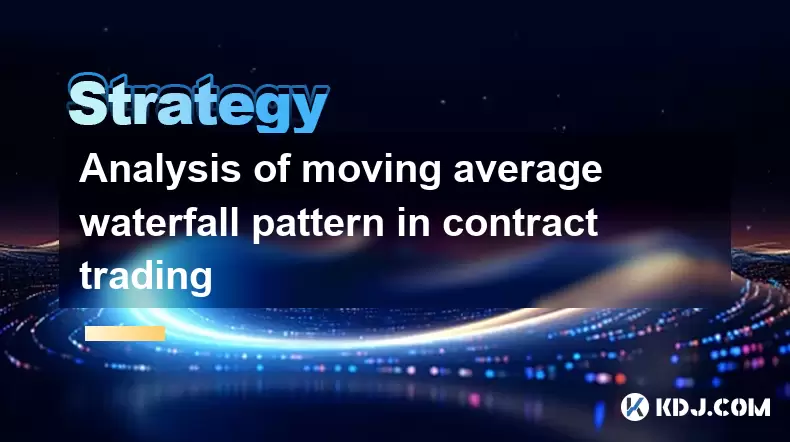-
 bitcoin
bitcoin $120167.907534 USD
1.27% -
 ethereum
ethereum $4468.611945 USD
2.53% -
 xrp
xrp $3.013607 USD
1.80% -
 tether
tether $1.000549 USD
-0.01% -
 bnb
bnb $1092.592149 USD
6.28% -
 solana
solana $231.391244 USD
4.59% -
 usd-coin
usd-coin $0.999699 USD
-0.04% -
 dogecoin
dogecoin $0.259020 USD
4.30% -
 tron
tron $0.342747 USD
0.34% -
 cardano
cardano $0.860977 USD
1.07% -
 hyperliquid
hyperliquid $50.155412 USD
5.34% -
 chainlink
chainlink $22.637678 USD
0.46% -
 ethena-usde
ethena-usde $1.000528 USD
-0.07% -
 avalanche
avalanche $30.613779 USD
-0.07% -
 stellar
stellar $0.403905 USD
0.94%
Analysis of moving average waterfall pattern in contract trading
The moving average waterfall pattern, a key tool in crypto contract trading, signals strong trends when shorter-term averages cross above or below longer-term ones.
Jun 09, 2025 at 07:07 am

The moving average waterfall pattern is a significant technical analysis tool used by traders in the cryptocurrency market, particularly in contract trading. This pattern, when identified correctly, can provide insights into potential market trends and help traders make informed decisions. In this article, we will delve into the intricacies of the moving average waterfall pattern, its identification, and how it can be utilized effectively in contract trading.
Understanding the Moving Average Waterfall Pattern
The moving average waterfall pattern is characterized by a series of moving averages arranged in a cascading manner. This pattern typically indicates a strong trend in the market, either bullish or bearish. The waterfall effect is created when shorter-term moving averages cross above or below longer-term moving averages in a sequential order. For instance, in a bullish scenario, the 10-day moving average might cross above the 20-day, which in turn crosses above the 50-day, and so on.
To identify this pattern, traders often use multiple moving averages of varying lengths. Common moving averages used include the 10-day, 20-day, 50-day, 100-day, and 200-day. The key is to observe the alignment of these moving averages. In a bullish waterfall, shorter-term moving averages will be positioned above longer-term ones, while in a bearish waterfall, the reverse is true.
Identifying the Bullish Moving Average Waterfall Pattern
To spot a bullish moving average waterfall pattern, follow these steps:
- Select your moving averages: Choose a set of moving averages, such as the 10-day, 20-day, 50-day, 100-day, and 200-day.
- Observe the alignment: Look for a situation where the 10-day moving average crosses above the 20-day, the 20-day crosses above the 50-day, the 50-day crosses above the 100-day, and the 100-day crosses above the 200-day.
- Confirm the trend: Ensure that the price action supports the bullish trend indicated by the moving averages. The price should be consistently above the moving averages, and the moving averages should be sloping upwards.
Identifying the Bearish Moving Average Waterfall Pattern
Identifying a bearish moving average waterfall pattern involves a similar process but in reverse:
- Select your moving averages: Use the same set of moving averages as mentioned above.
- Observe the alignment: Look for a situation where the 10-day moving average crosses below the 20-day, the 20-day crosses below the 50-day, the 50-day crosses below the 100-day, and the 100-day crosses below the 200-day.
- Confirm the trend: Ensure that the price action supports the bearish trend indicated by the moving averages. The price should be consistently below the moving averages, and the moving averages should be sloping downwards.
Utilizing the Moving Average Waterfall Pattern in Contract Trading
In contract trading, the moving average waterfall pattern can be a powerful tool for making trading decisions. When a bullish waterfall pattern is identified, it may signal a good opportunity to enter long positions. Conversely, a bearish waterfall pattern may suggest a time to enter short positions.
Here's how you can utilize this pattern in your trading strategy:
- Entry points: For a bullish waterfall, consider entering a long position when the shortest-term moving average (e.g., 10-day) crosses above the next longer-term moving average (e.g., 20-day). For a bearish waterfall, enter a short position when the shortest-term moving average crosses below the next longer-term moving average.
- Exit points: Use the reversal of the waterfall pattern as an exit signal. For instance, if you are in a long position based on a bullish waterfall, consider exiting when the shortest-term moving average begins to cross below the next longer-term moving average.
- Risk management: Always set stop-loss orders to manage your risk. For a long position, place a stop-loss below the last moving average in the waterfall sequence. For a short position, place a stop-loss above the last moving average in the sequence.
Combining the Moving Average Waterfall Pattern with Other Indicators
While the moving average waterfall pattern can be a strong indicator on its own, combining it with other technical indicators can enhance its effectiveness. Some common indicators to consider include:
- Relative Strength Index (RSI): Use the RSI to confirm overbought or oversold conditions. A bullish waterfall pattern combined with an RSI below 30 may indicate a strong buying opportunity.
- MACD (Moving Average Convergence Divergence): The MACD can help confirm the trend indicated by the moving average waterfall pattern. A bullish crossover in the MACD can reinforce a bullish waterfall pattern.
- Volume: High trading volume can confirm the strength of the trend indicated by the moving average waterfall pattern. A bullish waterfall pattern with increasing volume may suggest a robust upward trend.
Practical Example of the Moving Average Waterfall Pattern in Action
Let's consider a practical example of how the moving average waterfall pattern might play out in the cryptocurrency market. Suppose you are monitoring Bitcoin (BTC) and notice the following sequence of moving average crossovers:
- Day 1: The 10-day moving average crosses above the 20-day moving average.
- Day 5: The 20-day moving average crosses above the 50-day moving average.
- Day 10: The 50-day moving average crosses above the 100-day moving average.
- Day 15: The 100-day moving average crosses above the 200-day moving average.
In this scenario, you have identified a bullish moving average waterfall pattern. The price of Bitcoin is consistently above all the moving averages, and the moving averages are sloping upwards. Based on this pattern, you decide to enter a long position on Bitcoin.
As the trend continues, you monitor the moving averages for any signs of reversal. After a few weeks, you notice that the 10-day moving average begins to cross below the 20-day moving average. This signals a potential reversal of the bullish waterfall pattern, prompting you to exit your long position and take profits.
Frequently Asked Questions
Q: Can the moving average waterfall pattern be used for short-term trading?A: Yes, the moving average waterfall pattern can be adapted for short-term trading by using shorter-term moving averages. For example, you could use 5-day, 10-day, 20-day, and 50-day moving averages to identify short-term trends. However, keep in mind that shorter-term moving averages may generate more false signals, so it's important to combine them with other indicators for confirmation.
Q: How do I determine the best moving averages to use for the waterfall pattern?A: The choice of moving averages depends on your trading style and timeframe. For long-term trading, consider using 50-day, 100-day, and 200-day moving averages. For medium-term trading, 20-day, 50-day, and 100-day moving averages might be more suitable. Experiment with different combinations to find what works best for your strategy.
Q: Is the moving average waterfall pattern effective in all market conditions?A: The moving average waterfall pattern is most effective in trending markets. In sideways or choppy markets, the pattern may generate false signals. Therefore, it's crucial to assess the overall market conditions and use additional indicators to confirm the trend before making trading decisions based on the waterfall pattern.
Q: Can the moving average waterfall pattern be used for other cryptocurrencies besides Bitcoin?A: Yes, the moving average waterfall pattern can be applied to any cryptocurrency that exhibits sufficient trading volume and liquidity. However, the effectiveness of the pattern may vary depending on the specific cryptocurrency and market conditions. Always conduct thorough analysis and backtesting before applying the pattern to a new cryptocurrency.
Disclaimer:info@kdj.com
The information provided is not trading advice. kdj.com does not assume any responsibility for any investments made based on the information provided in this article. Cryptocurrencies are highly volatile and it is highly recommended that you invest with caution after thorough research!
If you believe that the content used on this website infringes your copyright, please contact us immediately (info@kdj.com) and we will delete it promptly.
- BlockDAG, DOGE, HYPE Sponsorship: Crypto Trends Shaping 2025
- 2025-10-01 00:25:13
- Deutsche Börse and Circle: A StableCoin Adoption Powerhouse in Europe
- 2025-10-01 00:25:13
- BlockDAG's Presale Buzz: Is It the Crypto to Watch in October 2025?
- 2025-10-01 00:30:13
- Bitcoin, Crypto, and IQ: When Genius Meets Digital Gold?
- 2025-10-01 00:30:13
- Stablecoins, American Innovation, and Wallet Tokens: The Next Frontier
- 2025-10-01 00:35:12
- NBU, Coins, and Crypto in Ukraine: A New Yorker's Take
- 2025-10-01 00:45:14
Related knowledge

Practical parameter settings for a Bitcoin multi-timeframe moving average system
Sep 18,2025 at 10:54pm
Optimizing Timeframe Combinations for Bitcoin Trading1. Selecting appropriate timeframes is crucial when building a multi-timeframe moving average sys...

How can I filter out false breakouts in Dogecoin high-frequency trading?
Sep 22,2025 at 01:00am
Understanding False Breakouts in Dogecoin Trading1. A false breakout occurs when Dogecoin's price appears to move beyond a defined support or resistan...

Techniques for identifying tops and bottoms in the Bitcoin on-chain NVT model
Sep 20,2025 at 07:54pm
Understanding the NVT Model in Bitcoin Analysis1. The Network Value to Transactions (NVT) ratio is often described as the 'P/E ratio' of the cryptocur...

What does the surge in open interest in Bitcoincoin futures mean?
Sep 20,2025 at 11:18pm
Understanding the Surge in Dogecoin Futures Open Interest1. A surge in open interest within Dogecoin futures indicates a growing number of active cont...

How can I use the Ethereum USDT premium to gauge market sentiment?
Sep 18,2025 at 11:55pm
Understanding the Ethereum USDT Premium1. The Ethereum USDT premium refers to the price difference between USDT (Tether) traded on Ethereum-based plat...

What should I do if Ethereum staking yields decline?
Sep 20,2025 at 06:18am
Understanding the Causes Behind Declining Ethereum Staking Yields1. The Ethereum network transitioned to a proof-of-stake consensus mechanism with the...

Practical parameter settings for a Bitcoin multi-timeframe moving average system
Sep 18,2025 at 10:54pm
Optimizing Timeframe Combinations for Bitcoin Trading1. Selecting appropriate timeframes is crucial when building a multi-timeframe moving average sys...

How can I filter out false breakouts in Dogecoin high-frequency trading?
Sep 22,2025 at 01:00am
Understanding False Breakouts in Dogecoin Trading1. A false breakout occurs when Dogecoin's price appears to move beyond a defined support or resistan...

Techniques for identifying tops and bottoms in the Bitcoin on-chain NVT model
Sep 20,2025 at 07:54pm
Understanding the NVT Model in Bitcoin Analysis1. The Network Value to Transactions (NVT) ratio is often described as the 'P/E ratio' of the cryptocur...

What does the surge in open interest in Bitcoincoin futures mean?
Sep 20,2025 at 11:18pm
Understanding the Surge in Dogecoin Futures Open Interest1. A surge in open interest within Dogecoin futures indicates a growing number of active cont...

How can I use the Ethereum USDT premium to gauge market sentiment?
Sep 18,2025 at 11:55pm
Understanding the Ethereum USDT Premium1. The Ethereum USDT premium refers to the price difference between USDT (Tether) traded on Ethereum-based plat...

What should I do if Ethereum staking yields decline?
Sep 20,2025 at 06:18am
Understanding the Causes Behind Declining Ethereum Staking Yields1. The Ethereum network transitioned to a proof-of-stake consensus mechanism with the...
See all articles










































































